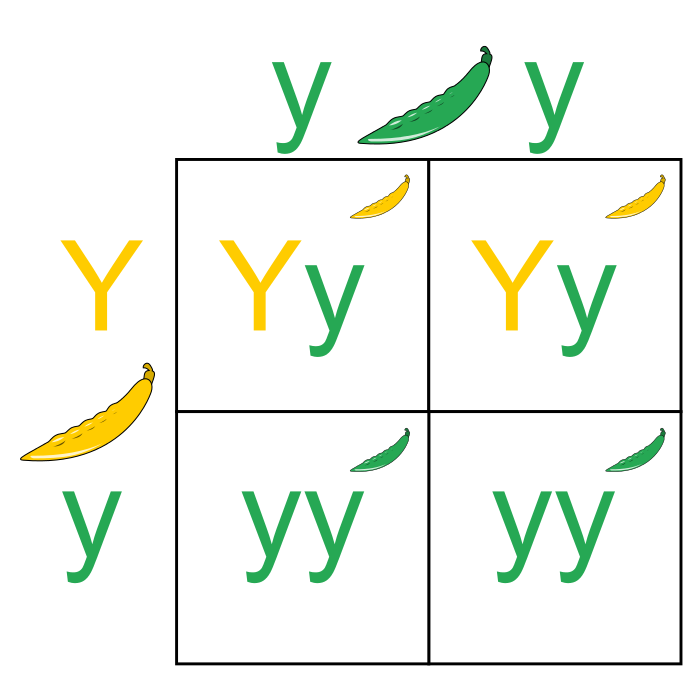Haseung Jun
Caroline Koffke
Haseung Jun
Caroline Koffke
AP Biology 🧬
358 resourcesSee Units
The Father of Modern Genetics
Gregor Mendel, the father of modern genetics, came up with some really important laws, including the law of independent assortment, that allows for scientists to determine how genes are inherited from generation to generation.
DNA
DNA and RNA are carriers of genetic information. This RNA is used to create proteins, so ribosomes (protein factory) is found in all forms of life.
Law of Segregation
The law of segregation states that the two alleles from each parent are segregated during gamete formation. Essentially, each gamete gets only one of the two copies of the gene.
Law of Independent Assortment
The law of independent assortment states that the two alleles get split up without regard to how the other alleles get split up. This means that you can get your father's copy of genes for eye color, but that doesn't mean you'll also get your father's copy of genes of hair color; you might get your mother's.
Essential Vocabulary
Phenotype - the physical appearance of an organism, or the actual depiction of a trait (think: phenotype, PHYSICAL). Ex. red, purple, white, sparkly, spiky.
Genotype - the alleles that make up an individual trait (think: genotype, GENES). Ex. AA, Aa, aa OR homozygous dominant, heterozygous, homozygous recessive.
Allele - a version of a gene. Usually an allele can be dominant or recessive. For Mendelian genetics, all genes have two alleles.
Homozygous Recessive - an organism that has two recessive alleles. The organism will have the recessive phenotype.
Dominant - a trait that produces enough protein or product in order to overtake another trait.
Recessive - a trait that does not produce enough protein or product and is overpowered by dominant traits.
Homozygous Dominant - an organism that has two dominant alleles. The organism will have the dominant phenotype.
Heterozygous - an organism that has one dominant and one recessive allele. The organism will have the dominant phenotype.
Punnett Squares
Note that only the homozygous recessive genotype leads to the recessive phenotype. All of the vocabulary above is used frequently and should be memorized and thoroughly understood.
Because of the rules that Mendel created, the frequency of inheritance can be determined when two individuals are crossed. This can be shown with a Punnett Square.

Image courtesy of WikiMedia Commons.
As shown in the Punnett square above, when a heterozygous (Yy) and homozygous recessive (yy) individual is crossed, there is a 50% chance that the offspring will show the dominant (yellow) phenotype and a 50% chance that the offspring will show the recessive (green) phenotype.
This can be done for any trait that has a simple inheritance pattern. By knowing the genotype of the parents, the various possible offspring can be calculated with their frequencies.
The probability of having children with a certain trait can be calculated by the laws of probability. In most cases, you'll multiply the probability of having a certain trait with another trait. For example, the probability of having a child with brown eyes or blue eyes will be just multiplying the probability of a child having brown eyes times the probability of a child having blue eyes.

Image Courtesy of College Board
Unfortunately, most traits do not have a simple dominant/recessive inheritance pattern and, therefore, do not fit Mendel’s rules. These traits, referred to as Non-Mendelian traits, are explained next.
Pattern of Inheritance
Like regular Punnett square inheritance, these other patterns can be found using Punnett squares. The example shown above is an example of monohybrid inheritance.
Dihybrid
This inheritance pattern is just like monohybrid, except two genes are looked at. When you look at the Punnett square, you'll get 16 offspring.

Image Courtesy of Expii
If both genes are crossed, you'll actually get a magic ratio of 9:3:3:1 for phenotypes (beware, this is not genotype!), which can be useful when you don't really want to actually calculate out the full Punnett square.
Sex-linked
Sex-linked genes involve genes that are linked to our X and Y chromosomes instead of our other chromosomes. Traits such as color blindness and hemophilia are sex-linked traits. With these sex-linked traits, you are affected if all your X chromosomes have the sex-linked gene. Since males only have one X chromosome, they are more likely to be affected. This is why men are more likely to be color-blind as opposed to women. If a female has a X chromosome that is affected by the gene, she won't express it because it'll be recessive. In order to be color-blind, she would have to have two X chromosomes that are both affected by the gene. A female with only one color blind X chromosome is called a carrier, because though she herself is not color-blind, she can still pass it onto her children.

Image Courtesy of Shemmassian
In the above Punnett square, you can tell a carrier female and normal male have a 50% chance of having a non-color-blind child. They have a 25% chance of having a carrier daughter and 25% chance of having a color-blind son.
Check out the AP Bio Unit 5 Replays or watch the 2021 Unit 5 Cram
Browse Study Guides By Unit
🧪Unit 1 – Chemistry of Life
🧬Unit 2 – Cell Structure & Function
🔋Unit 3 – Cellular Energetics
🦠Unit 4 – Cell Communication & Cell Cycle
👪Unit 5 – Heredity
👻Unit 6 – Gene Expression & Regulation
🦍Unit 7 – Natural Selection
🌲Unit 8 – Ecology
👏General Review
🧐Multiple Choice Questions (MCQ)
✍️Free Response Questions (FRQ)
📆Big Reviews: Finals & Exam Prep

© 2023 Fiveable Inc. All rights reserved.